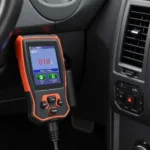Intake air temperature (IAT) plays a crucial role in your engine’s performance and efficiency. Your car’s computer, or Engine Control Unit (ECU), uses the IAT sensor to monitor the air temperature entering the engine and adjust the fuel-air mixture accordingly. Understanding the IAT OBD2 normal range and how to diagnose potential issues is vital for maintaining optimal engine health.
What Does the IAT Sensor Do?
The IAT sensor, typically located in the intake manifold or air intake duct, measures the temperature of the incoming air. This information is relayed to the ECU, which uses it to:
- Optimize Air-Fuel Ratio: Warmer air is less dense, requiring less fuel for combustion. Conversely, colder air is denser and necessitates more fuel.
- Adjust Ignition Timing: The ECU can advance or retard ignition timing based on the IAT readings to ensure efficient combustion.
- Control Emissions: Maintaining the correct air-fuel ratio is critical for minimizing harmful emissions.
IAT OBD2 Normal Range
While the specific IAT OBD2 normal range may vary slightly depending on the vehicle make and model, a general rule of thumb is between -40°F to 257°F (-40°C to 125°C). It’s essential to consult your vehicle’s owner’s manual or a reliable online database for the precise specifications for your car.
Common Symptoms of a Faulty IAT Sensor
A malfunctioning IAT sensor can disrupt your engine’s performance and lead to various issues, including:
- Check Engine Light Illumination: One of the first signs of a problem is often the illumination of the check engine light on your dashboard.
- Increased Fuel Consumption: An inaccurate IAT reading can result in an overly rich or lean air-fuel mixture, leading to reduced fuel efficiency.
- Rough Engine Idle: If the ECU receives incorrect temperature data, it can disrupt the idle speed control, leading to a rough or erratic idle.
- Hesitation or Stalling: Inconsistent IAT readings can cause hesitation or stalling during acceleration due to improper fuel delivery.
- Black Smoke from Exhaust: A rich air-fuel mixture caused by a faulty IAT sensor can lead to black smoke emanating from the exhaust pipe.
Diagnosing IAT Sensor Problems
If you suspect a problem with your IAT sensor, you can perform a few diagnostic steps:
- Read OBD2 Codes: An OBD2 scanner can retrieve diagnostic trouble codes stored in the ECU. Codes related to the IAT sensor will pinpoint the issue.
- Check Sensor Resistance: Using a digital multimeter, you can measure the resistance across the IAT sensor’s terminals. Compare the readings to the manufacturer’s specifications to determine if it’s within range.
- Visual Inspection: Inspect the IAT sensor and its wiring for any visible damage, such as cracks, corrosion, or loose connections.
Expert Insight: “A common mistake when diagnosing IAT sensor issues is overlooking potential wiring problems. Always inspect the wiring harness for any damage before replacing the sensor itself.” – John Miller, Senior Automotive Technician
Conclusion
Monitoring your IAT OBD2 normal range is essential for ensuring optimal engine performance, fuel efficiency, and reduced emissions. If you experience any symptoms of a faulty IAT sensor, it’s crucial to address the issue promptly to prevent further complications.
Remember, regular vehicle maintenance and timely repairs contribute to a smoother, more efficient, and enjoyable driving experience.
If you’re interested in learning more about OBD2 scanners and how they can help you diagnose and resolve car problems, check out our articles on obd2 scanner read transmission temperature and [what is a obd2 pending code](https://obdfree.com/what is a obd2 pending code/). For specific car model issues, you can find articles like live obd2 monitoring scion frs or volvo v70 obd2 1 p0756 on our website. We also have resources for troubleshooting specific error codes, such as chrysler obd2 code p0304.
Need further assistance? Feel free to reach out to our team via WhatsApp at +1(641)206-8880 or email us at [email protected]. Our dedicated customer support team is available 24/7 to answer your questions and provide guidance.


